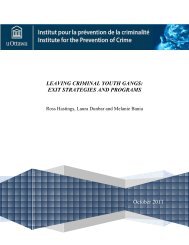Prevention by Design in Ottawa: Toward a Strategic Approach to ...
Prevention by Design in Ottawa: Toward a Strategic Approach to ...
Prevention by Design in Ottawa: Toward a Strategic Approach to ...
Create successful ePaper yourself
Turn your PDF publications into a flip-book with our unique Google optimized e-Paper software.
Crime <strong>Prevention</strong> <strong>Ottawa</strong> 2<br />
Study and Recommendations for CPTED <strong>in</strong> <strong>Ottawa</strong>January 19, 2009<br />
2.0 CPTED and defensible space<br />
Fences, locks, and surveillance have long been used <strong>to</strong> protect people and property. Researchers<br />
and practitioners have built upon these practices <strong>by</strong> try<strong>in</strong>g <strong>to</strong> understand the relationship between<br />
physical design and levels of crim<strong>in</strong>al activity, and then <strong>by</strong> manipulat<strong>in</strong>g design <strong>to</strong> reduce the<br />
<strong>in</strong>cidence of crime. This type of crime prevention is called crime prevention through<br />
environmental design (CPTED), and it focuses on the design of build<strong>in</strong>gs and other<br />
<strong>in</strong>frastructure and on their geographical placement. CPTED is based on the view that the built<br />
environment affects crime. Crime is not randomly distributed but is concentrated <strong>in</strong> some<br />
locations. There are many reasons why some places have higher crime rates than other places;<br />
one reason is the built environment.<br />
Crime prevention through environmental design (CPTED) <strong>in</strong>volves understand<strong>in</strong>g the<br />
relationship between physical design and levels of crim<strong>in</strong>al activity, and then manipulat<strong>in</strong>g<br />
design <strong>to</strong> reduce the <strong>in</strong>cidence of crime. There is a grow<strong>in</strong>g body of evidence which suggests<br />
that CPTED can reduce crime and fear of crime.<br />
CPTED is based on rational choice theory, which claims that crime is the result of deliberate<br />
choices made <strong>by</strong> offenders based on their calculation of the risks and rewards <strong>in</strong>volved with<br />
these choices. Rational choice theory does not focus on the <strong>in</strong>dividual‟s background, but rather<br />
on the situational fac<strong>to</strong>rs <strong>in</strong>volved <strong>in</strong> decid<strong>in</strong>g whether or not <strong>to</strong> commit a crime. The essence of<br />
CPTED and other types of situational crime prevention is the idea that crim<strong>in</strong>als will be deterred<br />
if the environment can be changed <strong>to</strong> <strong>in</strong>crease the perceived risk, <strong>in</strong>crease the effort, or reduce<br />
the rewards of committ<strong>in</strong>g an offense.<br />
There is a grow<strong>in</strong>g body of evidence which suggests that CPTED can reduce crime and fear of<br />
crime. Appendix D describes evaluation research that has been done on several CPTED<br />
programs (Secured <strong>by</strong> <strong>Design</strong> and Graffiti Clean Up Programs) and tactics (street closures,<br />
public hous<strong>in</strong>g renewal, closed circuit television, street light<strong>in</strong>g, convenience s<strong>to</strong>re ord<strong>in</strong>ances,<br />
and target harden<strong>in</strong>g).
















